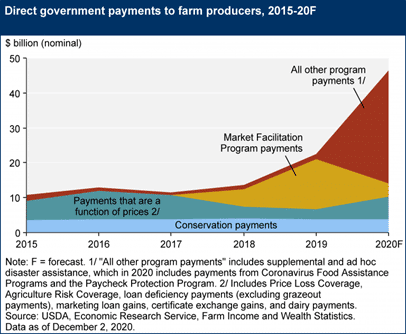2021 Farm Income Outlook
Net farm income increased an estimated 43 percent from 2019 to the end of 2020.
The U.S. Department of Agriculture (USDA) releases farm income data three times a year. In 2020, these statistical forecasts fluctuated dramatically. The first report, published in February of 2020, predicted a mild increase in net farm income from 2019 to $96.7 billion.
Fast forward to the latest USDA farm income report in December of 2020, with more than $2.5 trillion in federal relief accounted for and more on the way. The net farm income forecast reached $119.6 billion—nearly $23 billion more than initial predictions at the start of 2020.
Yet when one dives deeper into the report, it’s evident that these headline numbers don’t capture the whole story. A few more USDA statistics stand out in the latest report for farm income in 2020.
- Farm cash receipts were forecasted to decrease $3.2 billion or 0.9 percent;
- Animal products cash receipts carried the highest rate of decline, at $9.7 billion or 5.5 percent;
- Total crop receipts increased $6.5 billion YOY or 3.3 percent;
- Direct government payments (excluding USDA loans and insurance indemnity payments) increased $24 billion or 107.1 percent from 2019;
- Farm sector debt was forecasted to rise 4 percent with real estate debt at 6.1 percent; and
- Working farm capital was expected to increase 6 percent in 2020, compared to an 11.9 percent increase in 2019.
As you dive deeper into the numbers it becomes more apparent that the ag industry’s reliance on ad hoc payments has increased. The uncertainty of 2020 will likely linger into 2021, making farm budgeting and risk management essential to building a resilient 2021 business strategy.
Top Three Influential Factors Impacting Farm Income in 2021
Based on a recent statistical analysis of the agricultural sector, we’ve identified three key factors that will affect how farm income will look in 2021.
1. Global Trade Relations
Higher market prices in the second half of 2020 have been a bright spot in an uncertain economic landscape. Corn and soybean cash prices increase more than 30 percent from August to November due to substantial export purchases and continue to steadily rise as we head into 2021.
However, the influx in commodity prices and increased trade activity with China are met with an eye of skepticism as to how long it will last. Farmer optimism that the ongoing trade debate between the U.S. and China would favor American agriculture has declined from 76 percent to 47 percent when compared to the sentiment expressed in the first quarter of 2020.
While it is predicted the incoming administration will create needed stability in U.S. global trade relations, the outcome predictions are split—just over half of the survey respondents expect to see an increase in U.S. ag exports over the next five years.
2. Federal Assistance
COVID-19 marked a time of widespread supply chain disruption that needed immediate federal relief to support businesses and individuals through mandated lockdowns. Strong crop prices and stable trade relations could greatly improve U.S. farmers’ reliance on the record ad hoc payments many of them experienced in 2020.
Federal assistance was single-handedly the biggest factor impacting farm income in 2020. Direct government farm payments increased more than 107 percent in 2020 when compared to 2019, and accounted for nearly 40 percent of farm income. A vast majority of these payments were through the Payment Protection Program (PPP), the Coronavirus Food Assistance Program (CFAP), and the Market Facilitation Program (MFP)—all of which are not guaranteed in the coming year.
In 2021, it is predicted that a heavier focus will be placed on the long-term structural reform to reduce federal reliance and support a sustainable cash market.
3. Climate Change
The incoming administration has been vocal about taking aggressive measures to tackle climate change, which has the capacity to both benefit and restrict farmer’s potential income in 2021. It’s a crucial topic to address as it has directly impacted farmers year after year. In fact,
- Recorded global natural disaster events increased more than 43 percent in the past two decades compared to two decades prior.
- Acreage burned from California wildfires in 2020 increased 94 percent compared to acreage burned in 2019, totaling over four million acres.
- This year generated 30 named storms, the most on record, including 13 hurricanes.
There are two main ways the Biden administration plans to address the issue of climate change: environmental regulations and carbon markets.
Land stewardship is a task farmers and ranchers do not take lightly. Restrictions created in the past have unnecessarily burdened American farms and limited their ability to do their job effectively. The incoming administration has reiterated the importance of listening to both sound science and the voices of those potentially impacted when reforming existing regulations. It’s with great hope that this approach will lead to thoughtful voluntary reform that takes the perspectives of farmers into account, but many are apprehensive. More than 80 percent of farmers expected environmental regulations to become more restrictive as of December 2020, compared to 41 percent in October 2020.
On the other hand, the federal government plans to catch up with state and privately-owned company initiatives to provide carbon credits and subsidies for farmers who comply with voluntary regenerative agricultural practices, such as carbon crops and no-till farming. Through these programs, farmers will have the opportunity to increase revenue streams. However, these practices can require high capital investment to implement.
Here to Support the Future of Your Farm
The current low-interest-rate environment can benefit farmers who are interested in securing financing for initial operating costs, whether it’s through the refinance of existing debt or a line of credit. Farmers currently have a unique opportunity to lock in historically low-interest rates on new loans to help them build operational resilience that can withstand whatever the future holds.
AgAmerica is committed to supporting the long-term success of American family farm operations nationwide. Along with providing a wide range of flexible and customizable loan programs, we closely monitor the economic climate to provide insightful resources to help you make the best decisions for your operation with the help of AgAmerica’s Chief Economist, Dr. John Penson.
Sign up for our newsletter below to stay informed on the upcoming release of our in-depth economic analysis of U.S. agriculture in 2021.







